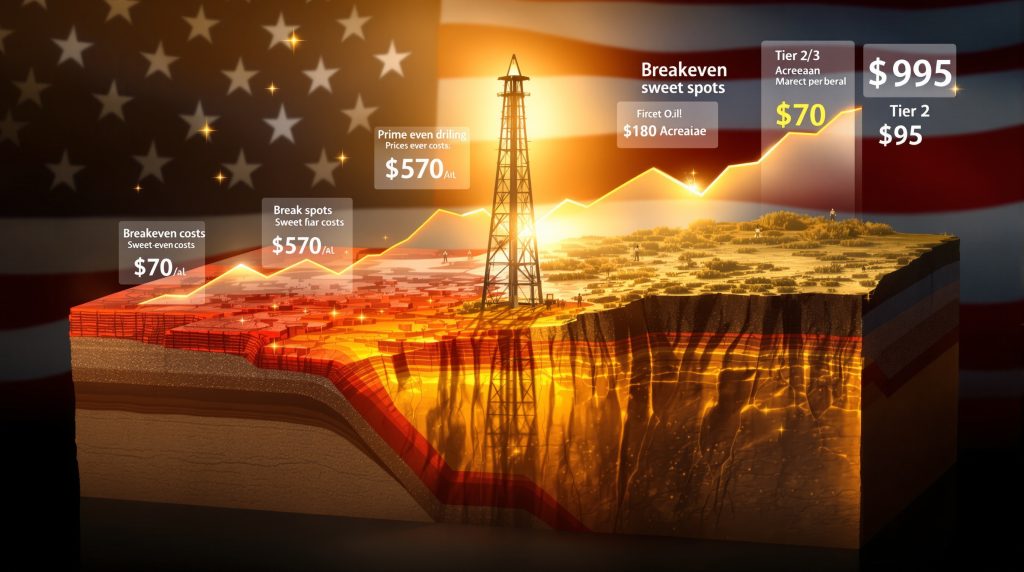Why Are U.S. Shale Oil Production Costs Increasing?
The U.S. shale oil industry is undergoing a profound transformation as production costs rise dramatically. After years of technological advancements that drove down breakeven costs, the sector now faces a new phase characterized by higher costs in US shale oil industry and diminishing returns. This shift threatens to reshape America's position in global energy markets and alter investment strategies across the industry.
Production costs are increasing due to several converging factors that are fundamentally changing the economics of shale oil extraction. While earlier innovations like multi-stage fracturing and pad drilling successfully reduced costs, these efficiency gains are now being offset by growing challenges in the field.
The primary drivers of rising costs include the depletion of prime drilling locations, increasing technical complexity of remaining reserves, escalating service and equipment costs, labor market constraints, and heightened regulatory compliance expenses. According to industry analysts from Enverus Intelligence Research, these combined pressures are pushing breakeven costs significantly higher across all major U.S. shale basins.
As Alex Ljubojevic, director at Enverus, notes: "As core shale oil inventory in the U.S. depletes, the industry is entering a new era of higher costs and more complex development." This transition marks the end of an era of continuously declining production costs that had made U.S. shale so competitive globally.
How Much Are Breakeven Costs Expected to Rise?
The financial outlook for U.S. shale producers is becoming increasingly challenging as breakeven costs climb steadily upward. Current projections paint a concerning picture for the industry's long-term cost structure.
According to comprehensive analysis from Enverus Intelligence Research, breakeven costs are expected to rise from approximately $70 per barrel WTI in 2025 to as high as $95 per barrel by the mid-2030s. This represents a potential 35% increase in breakeven costs over the next decade, a dramatic shift that would fundamentally alter the economics of U.S. shale production.
The following table illustrates the projected trajectory of breakeven costs:
| Timeframe | Average Breakeven Cost (WTI) | Key Drivers |
|---|---|---|
| 2025 | $70 per barrel | Core inventory depletion, inflation |
| 2030 | $82-85 per barrel (est.) | Transition to tier 2/3 acreage |
| Mid-2030s | $95 per barrel (projected) | Predominantly lower-quality drilling inventory |
Not all shale regions will experience identical cost increases. The Permian Basin is likely to remain the most economical due to its larger remaining inventory of quality drilling locations, while other plays face steeper challenges. The Eagle Ford and Bakken formations are experiencing faster depletion of core acreage, driving higher cost increases. Some secondary basins could see breakevens exceed $100 per barrel sooner than the major plays.
What's Causing Core Inventory Depletion?
The concept of "core inventory depletion" is central to understanding the cost challenge facing U.S. shale producers. This phenomenon represents the gradual exhaustion of the most productive and economically viable drilling locations.
Shale resources are categorized into tiers based on productivity and economics:
- Tier 1 (Core): Prime locations with optimal geology, highest productivity, and lowest costs
- Tier 2: Moderate productivity, requires higher prices to be economic
- Tier 3: Challenging geology, substantially higher costs, marginal economics
The industry has naturally focused on developing Tier 1 resources first, but these prime locations are now increasingly depleted after more than a decade of intensive development. This strategy of prioritizing the best acreage made perfect economic sense, but it has accelerated the timeline for transitioning to less optimal drilling locations.
Industry data shows that the most productive "sweet spots" in many basins are already drilled, forcing companies to move to less optimal locations. This transition to less productive acreage directly translates to higher costs per barrel as companies need more wells, more complex completions, and more resources to produce the same amount of oil.
As the Dallas Fed Energy Survey reveals, this transition is already affecting operational decisions across the industry. Many executives report delaying investment decisions due to heightened uncertainty about oil prices and production costs, reflecting the challenging economics of developing lower-tier acreage.
How Are Rising Costs Affecting U.S. Production Growth?
The impact of rising costs extends beyond company balance sheets to affect overall U.S. production trends and global market influence. The era of rapid growth that defined the shale revolution appears to be ending.
U.S. shale production growth is already showing signs of moderation. Production growth rates have declined from double digits to low single digits in recent years. Declining rig counts have remained relatively flat despite price fluctuations, and producers are prioritizing cash flow over aggressive expansion.
Diamondback Energy CEO Kaes Van't Hof captured this sentiment in a recent shareholder letter, stating: "With volatility and uncertainty persisting, we see no compelling reason to increase activity this year." He further added his belief that "U.S. shale oil production has likely peaked at current oil prices."
The industry has shifted dramatically toward capital discipline, with most companies now focused on:
- Maintaining rather than growing production
- Generating free cash flow for shareholders
- Reducing debt levels
- Limiting capital expenditures to 70-80% of operating cash flow
This disciplined approach, combined with higher costs in US shale oil industry, means U.S. shale is unlikely to respond to higher prices with the same production surge seen in previous cycles. The days of rapid production growth in response to modest price increases appear to be over.
What Are The Global Market Implications?
The changing economics of U.S. shale production have significant implications for global oil markets and America's energy influence. As the cost structure of U.S. production rises, its role as the world's swing producer may diminish.
According to Enverus Intelligence Research, North America's contribution to global oil supply growth is expected to decline significantly—from supplying over 100% of global demand growth in the past decade to less than 50% in the coming decade. This shift creates space for other producers, particularly OPEC+ nations with lower production costs, to reassert market influence.
Higher U.S. breakeven costs could establish a higher floor for global oil prices, as the marginal barrel becomes more expensive to produce. This could lead to reduced price ceilings during downturns and potentially increase market volatility during supply disruptions.
As U.S. shale costs rise, other supply sources may become relatively more competitive. Canadian oil sands are projected to add 450,000 barrels per day by 2030 according to Enverus data. Offshore developments with longer production plateaus and OPEC market influence may also gain importance in global supply.
This shift could have geopolitical implications as well. The U.S. role as an energy superpower that helped stabilize markets may gradually diminish if production growth stalls and costs continue to rise.
How Are Companies Responding to Higher Costs?
Faced with rising costs and depleting inventory, U.S. shale companies are adapting their strategies in several ways to maintain competitiveness in a challenging environment.
Consolidation and Scale
Industry consolidation has accelerated as companies seek scale advantages to offset rising costs. Major mergers have created larger, more efficient operators with better economies of scale. Smaller independents are being acquired by larger players, and acreage positions are being consolidated to enable longer lateral wells.
This trend toward larger operators with more diverse portfolios helps mitigate some cost pressures through economies of scale. Consolidated operations allow companies to spread fixed costs across more production and gain leverage in negotiations with service providers.
Technological Innovation Focus
Companies are doubling down on technological solutions to offset rising costs:
- Advanced drilling techniques and longer laterals
- Enhanced completion designs and proppant optimization
- Digital technologies and automation to reduce labor costs
- Machine learning for better well placement and production optimization
These innovations may partially offset rising costs but are unlikely to fully counteract the fundamental challenges of depleting core inventory. The law of diminishing returns suggests that each new technological advance provides smaller benefits than the last.
Capital Allocation Strategies
Producers are adjusting capital allocation to focus on highest-return inventory first, maintenance rather than growth capital, diversification into other basins or conventional assets, and exploring international opportunities with better economics.
As one executive noted in the Dallas Fed Energy Survey, "The administration is pushing for $40 per barrel crude oil, and with tariff impacts on investments, [input] prices are up, and drilling is going to disappear." This sentiment reflects the challenging environment for capital allocation decisions.
What Role Do External Factors Play?
Beyond geology and operations, external factors are also influencing the cost trajectory for U.S. shale producers. These factors add another layer of complexity to an already challenging cost environment.
Regulatory Environment Impact
Regulatory changes can significantly affect operational costs through permitting timelines and requirements, emissions monitoring and reduction mandates, water management regulations, and land use restrictions. These regulatory factors vary by administration and region, creating additional uncertainty for long-term planning.
The Dallas Fed Energy Survey provides insight into this impact. Most executives (57%) estimate that regulatory changes since January 2025 have reduced their firms' breakeven costs for new wells by less than $1 per barrel. An additional 25% estimate reductions between $1 and $1.99 per barrel, while none of the large E&P firms have seen more than $5 per barrel cost reduction.
Supply Chain and Service Sector Dynamics
The oil services sector has undergone significant consolidation, affecting pricing power and creating challenges such as:
- Fewer service providers leading to less competitive pricing
- Equipment shortages during activity spikes
- Labor constraints, particularly for specialized roles
- Material cost inflation, especially for steel and chemicals
These supply chain factors have become more pronounced following industry contractions during recent downturns, which led to significant capacity reduction in the service sector.
Global Competition and Trade Policies
Trade policies and global competition also influence the cost structure through tariffs on imported equipment and materials, competition from lower-cost international producers, currency fluctuations affecting dollar-denominated costs, and export policies and infrastructure constraints.
What Does This Mean For Investors?
The changing economics of U.S. shale have important implications for energy investors, who must adapt their strategies to a new industry paradigm focused on returns rather than growth.
Investment Thesis Evolution
Investors in the shale sector are adjusting their expectations from growth-focused valuations to cash flow multiples. There's greater emphasis on inventory quality and longevity, premium valuations for operators with lower-cost positions, and increased scrutiny of technological differentiation.
The days of rewarding rapid production growth regardless of returns are over. Investors now prioritize sustainable business models with disciplined capital allocation and solid balance sheets.
Return of Capital Focus
Companies are increasingly focused on returning capital to shareholders through:
- Dividend yields becoming more important
- Share repurchase programs expanding
- Debt reduction prioritized over acquisitions
- Measured growth within cash flow
This shift represents a fundamental change in how the industry operates and how investors value shale companies. The focus has moved from "growth at all costs" to "profitable growth within means."
Valuation Metrics Shift
Valuation metrics are evolving to reflect the new reality. Enterprise value to EBITDA ratios have compressed, price-to-proved reserves are becoming more relevant, free cash flow yield has emerged as a primary metric, and inventory depth and quality are increasingly priced into valuations.
Investors are also placing greater emphasis on companies' ability to navigate the transition to higher-cost development while maintaining returns.
Can Technology Offset Rising Costs?
While technology has been a key driver of shale economics, its ability to offset rising costs faces limitations. The question is whether innovation can continue to deliver the dramatic improvements seen in the past.
Technological Frontiers
Several technological frontiers offer potential cost improvements:
- Machine learning for optimal well placement and spacing
- Advanced fracturing techniques for better recovery
- Automation to reduce labor requirements
- Enhanced oil recovery methods for shale
These advancements represent the industry's best hope for moderating the impact of rising costs and depleting core inventory.
Diminishing Returns Challenge
However, technological improvements face diminishing returns. Early innovations yielded 30-50% cost reductions, but recent advances typically deliver 5-15% improvements. Fundamental geological limitations cannot be overcome, and higher costs of implementing advanced technologies eat into their benefits.
The evolution of horizontal well lateral lengths illustrates both the power and limitations of technological solutions. Between 2010-2015, average laterals increased from 5,000 to 7,500 feet, yielding significant cost efficiencies. From 2015-2020, further increases to 10,000+ feet provided additional but smaller gains. In recent years, super-long laterals (15,000+ feet) have shown diminishing economic returns due to completion challenges and production interference.
This pattern of diminishing returns suggests that while technology will continue to improve, it may not be able to fully offset the fundamental challenge of depleting core inventory.
What's The Outlook For U.S. Shale?
The future of U.S. shale production will be shaped by the industry's response to rising costs and changing market dynamics. The path forward appears to be one of moderation rather than continued explosive growth.
Production Plateau Scenario
Many analysts project a production plateau scenario where U.S. oil production reaches 13-13.5 million barrels per day, maintains this level for several years through efficiency gains, then experiences gradual decline beginning in the late 2020s as core inventory depletes. Higher prices would be required to incentivize development of marginal resources.
This projection aligns with comments from industry leaders like Diamondback Energy's CEO, who believes U.S. shale production has likely peaked at current price levels.
Price Sensitivity Analysis
The industry's response to different price environments will vary significantly:
| WTI Price Level | Industry Response | Production Impact |
|---|---|---|
| Below $70/bbl | Significant activity reduction | Declining production |
| $70-85/bbl | Maintenance capital only | Flat production |
| $85-100/bbl | Moderate growth in best areas | Slow growth (2-3% annually) |
| Above $100/bbl | Acceleration of tier 2/3 inventory | Stronger growth but with higher costs |
This price sensitivity highlights the changed dynamics of U.S. shale, which now requires substantially higher prices to generate the kind of growth seen in previous cycles.
Long-Term Structural Shift
The industry appears to be undergoing a structural shift from disruptor to mature industry, from growth focus to cash generation, from independent wildcatters to integrated majors, and from price taker to price supporter.
This maturation process is natural for any industry, but it represents a significant change for a sector that has been defined by its disruptive impact on global energy markets.
Conclusion: The End of Cheap Shale?
The U.S. shale industry stands at a crossroads as rising costs challenge its position as the world's swing producer. The projected increase in breakeven costs from $70 to $95 per barrel represents a fundamental shift that will reshape global energy markets.
While technology, efficiency, and consolidation may mitigate some cost pressures, the geological reality of depleting core inventory suggests that the era of ever-cheaper shale production is ending. This transition will have far-reaching implications for energy security, market dynamics, and investment strategies.
The industry that revolutionized global oil markets through its rapid growth and flexibility now faces the constraints of resource maturity. How companies, investors, and policymakers respond to this new reality will determine the future role of U.S. shale in meeting global energy demand.
Key Takeaways
- U.S. shale breakeven costs are projected to rise from $70 to $95 per barrel by the mid-2030s
- Core inventory depletion is forcing development of less productive acreage
- North America's contribution to global oil supply growth is expected to fall below 50%
- Industry consolidation and technological innovation partially offset but cannot eliminate rising costs
- The era of U.S. shale as the dominant global swing producer may be waning
FAQ: Understanding Rising Costs in U.S. Shale
Will rising costs make U.S. shale uncompetitive globally?
While higher costs will reduce U.S. shale's competitive advantage, it remains more responsive than many alternatives. The $95 breakeven projection would still keep U.S. shale competitive with many offshore and international developments, though it would lose ground to low-cost OPEC production.
Could another technological breakthrough reverse the cost trend?
While technological innovation continues, transformative breakthroughs on the scale of horizontal drilling and multi-stage fracturing appear unlikely. Most current innovations offer incremental rather than revolutionary improvements, suggesting they may slow but not reverse the rising cost trend.
How will rising costs affect U.S. energy independence?
Higher production costs could gradually erode U.S. energy independence if they lead to declining domestic production. However, this would likely be a gradual process rather than a sudden shift, giving time for adaptation through efficiency improvements, alternative energy development, and consumption adjustments.
What does this mean for global oil prices?
Rising U.S. shale costs could establish a higher floor for global oil prices, as the marginal barrel becomes more expensive to produce. This could benefit low-cost producers while creating challenges for consumers and oil-importing nations accustomed to shale's oil price stagnation factors.
Will higher natural gas costs follow the same pattern?
Natural gas production faces similar challenges with core inventory depletion, though the economics differ somewhat from oil. Associated gas from oil wells may decrease as oil drilling moderates, potentially supporting higher natural gas prices and development of dedicated gas resources.
Further Exploration:
Readers interested in learning more about trends in the U.S. shale oil industry can explore related educational content about oil price rally analysis and the shifting dynamics of global energy markets.
Looking to Invest in the Next Major Mining Discovery?
Discover significant ASX mineral discoveries as they happen with Discovery Alert's proprietary Discovery IQ model, giving you actionable insights before the broader market moves. Explore why historic mineral discoveries have generated extraordinary returns by visiting Discovery Alert's dedicated discoveries page and start your 30-day free trial today.




